Naples-Capodichino Airport - It's the 16.00 of the afternoon when, after seven hours of delays due to ongoing operations on the USS Dwight D. Eisenhower where we are destined, we can take off. A first taxi to the runway has not seen us take off and return to the US Navy base station at 13.00.
The COD (Carrier Onboard Delivery, aircraft for the transport of personnel and / or materials), now has a small group of journalists, photographers and cameramen in the dark belly traveling to the US aircraft carrier (the figures often overlap).
Let's make a small parenthesis of aeronautical medicine. What causes airsickness (but also car sickness) is the inconsistency between what we perceive with our three main sensory centers: the eyes, the organs of balance in the inner ear and the backside. Imagine now you are belted at four points in a dark cockpit and ... with the seats reversed!
It means that the eyes will transmit a fixed image to a brain that perceives abnormal movements from the other centers of balance because the direction of travel is usually forward. If you then turn to peek through the only tiny side window you're done: after 20 minutes the faces are covered with cold sweat and, shortly thereafter, the drinks offered at the airport by the hosts just before take-off end in bags that have been meticulously delivered to everyone before departure. The worst air travel you can experience!
Meanwhile, cargo handling personnel move smoothly and without the slightest discomfort for the entire flight.
The landing that has been described to us as a "tremendous deceleration" (in fact it goes from 150 km / h to 0 in a second) is much less demanding than expected. The helmet and the inverted seat do their job very well. After two hours of agony in the air, even death would have been well received in order to end the torture.
We are on the "IKE". The COD tailgate opens. Teams with brightly colored jackets juggle around the aircraft. An F / A-18 slips behind the tailgate while we wait for green light to leave the aircraft.
As soon as we set foot on the flight deck we immediately realize that this is not a visit to a simple ship that passes through the Tyrrhenian Sea between Sardinia and the peninsula, it is the vessel of a country used to take full advantage of its war assets. In peace as in war.
Within an hour we are greeted by the formidable "Media" team, we are given the baggage we had left on the COD, we are given an accommodation with a magnetic key and we are fed into one of the many canteens that feed almost six thousand a day ( !) people between ship's crew and flight member (approx 3500 + 2500).
American cinema has accustomed us to consider them as a people of individualists. In reality what characterizes the men we face is the sincere ability to work in a team. The ship's teams work with extraordinary harmony in a giant that never shows a snag. As Chiara confides, our escort who has recently worked at the US Consulate in Naples, lworking with them is extremely motivating: excellent organization e always a plan B, C and D for any eventuality.
In the corridors, you never come across a traffic jam of people. You travel kilometers with the only trick of staying on one side when you stop to leave the transit free.
When we return to the bridge, F / A-18 takeoffs are still in progress.
One by one the steam catapults make fighter-bombers take off. White clouds of condensation run along the bridge at each launch. At a nod from our guide we have to kneel down to resist the jet of air from the jets taking off. The only devices allowed are cameras and video cameras with secure laces and balances, no cell phones for filming: a "flying object" on a flight deck in full operation like that could create a disaster. Think of a phone sucked into the air intake of one of those beasts.
Already those "beasts" ... It is here that I realize the inequality of the term "carrier" to describe generically the type of unit I am on. There are three main categories in the world: CATOBAR (with catapult for launching and stopping cables for aircraft landing), STOBAR (equipped with launch pad and stopping cables) and finally STOVL ( equipped with a trampoline but with vertical landing of the aircraft).
The abysmal difference is not so much in the consequent tonnage of the ship as in the aircraft on board, the real "fire power". The F / A-18 that are on the Eisenhower are fighter-bombers that can take off at full load of fuel and above all weapons. That of the weight of the fuel is however an easily manageable value since during a mission three or four refueling operations are also carried out in flight.
The aircraft on the STOVL aircraft carrier, like our dear old AV-8B Harrier II +, are instead multi-role aircraft with great limitations in terms of autonomy and war load. The technology will also be able to improve performance with the upcoming F-35 B but they will still be tremendously different aircrafts from the packaged version (F-35 C).
Perhaps it would be more correct to define the CATOBAR "mobile bases". Together with the destructive potential of the flagship, a Carrier strike group like that of the USS Dwight D. Eisenhower, sum that of missile launchers (USS San Jacinto, USS Monterey), destroyers (USS Roosevelt, USS Mason, USS Nitze, USS Stout) and one or two submarines (but never say). Submarines are obviously "nuclear": to keep up with ships traveling at 30 nodes (55 km / h) you need a certain "redundant boost". The USNS supply vessel must be added to the aforementioned Arctic.
We go down on the deck.
In one of the rooms dedicated to the pilots' briefing / debriefing, a friendly and well-trained liutenant Bates describes the aircraft loaded on the "IKE" starting from the history of the so-called "Gypsies" (Gypsies), his "Fighting Swordsmen" squadron (AC on the tail ) that has practically taken part in all the conflicts since the Second World War. The other three squadrons of the Carrier Air Wing three they are those of the "Gunslingers", the "Sidewinders" and the "Wildcats".
The F / A-18 F Super Hornets are the most advanced and equipped version of the machine produced by Boeing and the questions on the equipment that are placed by the most prepared and finicky among us journalists receive only positive answers.
It seems an episode of childhood when they exchanged the figurines: "I have it, I have it, I have it ...", not only the "missing" is heard.
How much the F / A-18 is an extraordinary machine, mature and still modern (it is an aircraft of gen. 4,5 that could be chosen by the new Canadian government instead of the F-35A) we are confirmed by the satisfaction of the pilots for the extension of maintenance in service required by the US Navy.
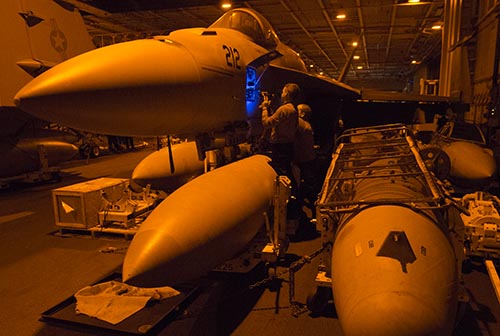
Satisfaction with the arrival of the F-35? Sure. But we do not want to embarrass with "politically incorrect" questions: it is clear that the twin-engine vessel today embarked can never be replaced by Lockheed Martin's single engine. The F / A-18 will almost certainly pass the baton to an F / A-XX in twenty years.
We leave the classroom for a new majestic destination.
The huge hangar we enter makes us understand why the air component is made up of more than 2000 men. If we think that for every hour of flight of an F / A-18 it takes about sixteen of maintenance, to understand why the staff is easy.
Around the aircraft, teams of technicians take turns to prepare fighters for the next mission, as well as transport and surveillance aircraft and helicopters.
On the Eisenhower there are 78 fixed or rotating wing aircraft, divided as follows:
4 squadrons of F / A-18 (SuperHornet ed Hornet)
1 squadron of E / A-18 (electronic warfare version)
1 squadron of E-2C (AWACS)
1 squadron of MH-60R Seahawk (multi-role helicopter with ASW / ASuW capacity)
1 squadron of MH-60S Seahawk (multi-role helicopter)
1 squadron of C-2A (transport plane, our COD!)
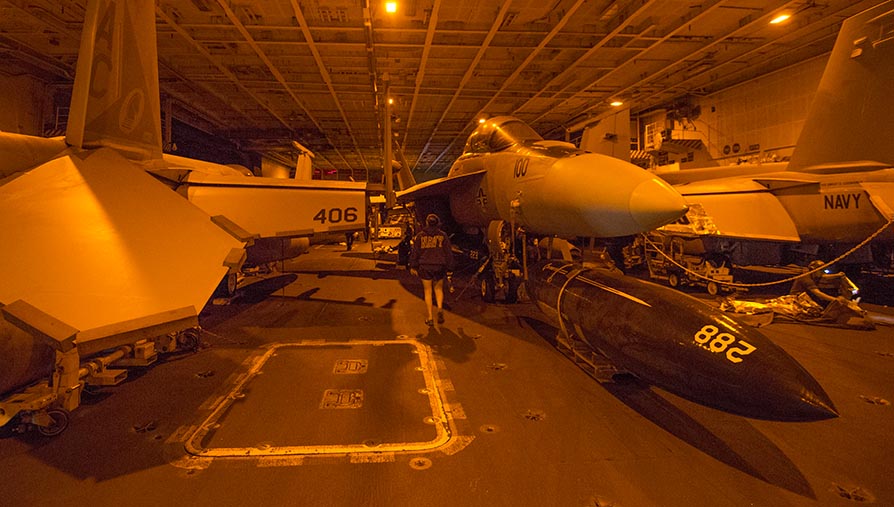
After witnessing a series of night landings from the top of the "island" we can retire to the lodgings.
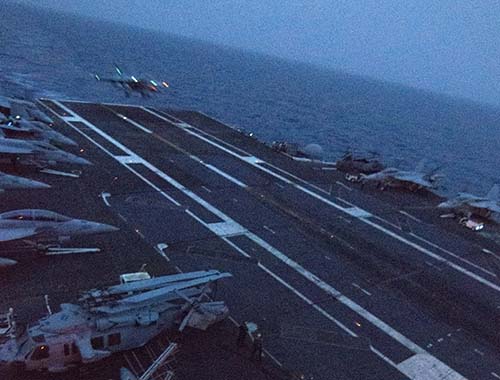 The embarrassment, with relative warning to my roommate, for being a bestial snorer has a short duration: take-offs and landings go on uninterrupted all night long. It seems to sleep under the launching deck and the vibrations produced by the catapult before and then by the arresting cables are felt with determination. At times it is difficult even to talk to each other in the house.
The embarrassment, with relative warning to my roommate, for being a bestial snorer has a short duration: take-offs and landings go on uninterrupted all night long. It seems to sleep under the launching deck and the vibrations produced by the catapult before and then by the arresting cables are felt with determination. At times it is difficult even to talk to each other in the house.
The following day we wake up fortunately half an hour before the time of the appointment: neither of the two occupants, between accumulated sleep and background noise, heard the two alarms pointed an hour before ... We have the availability of a bathroom with common shower on the bridge about fifty meters from the house. Turning from XXL with a size M bathrobe (but there is always the gap of at least one measure compared to our standards) along "night" corridors crossing some hatches of a nuclear aircraft carrier in shower slippers (!) Is a memory that I will bring with me for a long time. Fortunately I don't cross anyone on the way.
On ships the heads of catering are respected as much as and perhaps more than one admiral. And with missions seven months long, it's easy to understand why! Breakfast is excellent.
We reach the flight deck where, after the night maintenance works, the aircraft are deployed.
In the background the Vesuvius and the Bay of Naples where we enter the admiring glances of the boats that run alongside us, including cruise ships. Protection is guaranteed by the constant flight around the IKE of a Seahawk, as well as of course by the State Police and Coast Guard boats.
It is in the presence of other sea giants that the immensity of a Nimitz class can be appreciated: over 330 meters per 41 in height.
Now that activities in Italian territorial waters have subsided, we have the opportunity to enjoy that splendid landing strip. Soon we are joined by some Naval Group commanders.
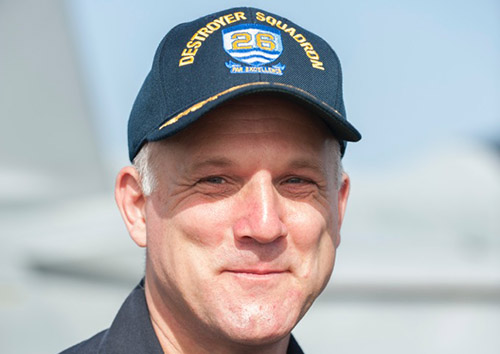
The first senior officer we meet is the commander of the Destroyer Squadron 26 (the USS Eisenhower support and protection units), capt. Scott Switzer.
In the 2008 an Italian submarine framed the IKE twin aircraft carrier, the USS Theodore Roosevelt, during an exercise. For seven years the embarrassing episode remained a secret among allies.
In the 2015, when the French succeeded, during COMPTUEX 2015, they immediately flaunted it with a "was the first submarine to have sunk an American nuclear-powered super aircraft carrier"(Except then cancel the press release from the website of the French Ministry of Defense).
Is the protection of an aircraft carrier a tougher job?
Commander Switzer answers: "Surely our task is not simple. At the moment, however, we deploy some of the best ships, equipped with the best equipment and the best crews in the world. The training of the on-board personnel has been brought to the highest levels. I am sure we can fulfill our task without problems."
We then meet the commander of Carrier Air Wing 3, capt. Jeffrey Anderson.
The presence of two aircraft carriers in the Mediterranean (the other is the USS Harry S. Truman), confirms, it is an unusual event even if the activity of the aircraft carrier on which we are is part of a normal time-programmed turnover.
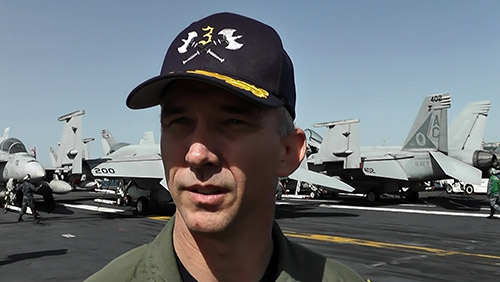
The theater (officially) interested by the USS Eisenhower should be the Syro-Iraqi one, the one occupied by ISIS: an array that in the last five months has received effective anti-aircraft endowments that led to the killing of several planes and helicopters, especially in Syrian territory .
We therefore ask if you do not fear that some "stupid" forget not to fire on them.
Commander Anderson's expression from funny and playful becomes extremely serious.
"We take every precaution to ensure that our aircraft and crews operate safely. I don't want to say that I'm not worried about the threat. What I can say for sure is that we do everything we can because our crews, constantly trained to face any eventuality, return unharmed."
Last but not least, we meet the commander of the Eisenhower Carrier Strike Group, Rear Admiral Jesse Wilson.
It tells of the importance of the "Great Green Fleet" program - "an initiative advanced by the US Navy secretary in the 2009 to make armed force less dependent on fossil fuels. The Italian Navy shared this goal. The agreement represents a milestone on a road that will be followed by many other nations. "
Smiling and determined, he looks like a movie character. With a deep and confident voice, he represents that incredible weapon waiting (?) For the next target. He does this especially when I ask if "the aircraft carrier" - today the most formidable military tool on the scene - could in a few decades become what the battleships were at the beginning of World War II.
“He is right when he emphasizes the incredible military capability of an aircraft carrier. With its aircraft and the ships that surround it, it can reach almost anywhere on the planet. This ability represents the sovereign peace of the United States. We go everywhere and operate without anyone's permission. This will remain unchanged for many years to come. The initiative dedicated to the use of green fuel will only improve the autonomy of our ships. "
We ask if he is not worried about the strong Chinese investments in so-called (hypersonic) missiles Carrier Killers.
"We are not afraid of anything. It's a question of organization: this Strike Group is trained to deal with all kinds of threats in offensive and defensive terms. We are ready!"
As an excellent communicator, he greets us with a "Grazi!"
After the last meal aboard the ship we envy some of those who remain on board, even if the "seven months!" Are expressed by the crew with a bit of melancholy for the families or friends left at home.
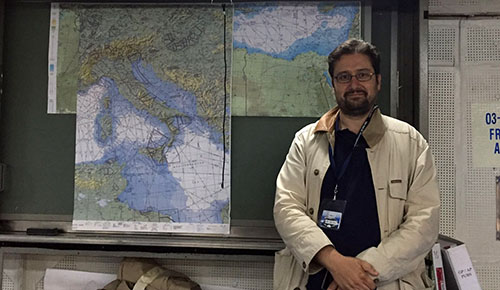 Before leaving the ship, some colleagues claim the purchase of some patches of the embarked flight departments. There are those who collect them and those who start right now. For the operation we end up in a pilot briefing room. While some pounce on a box full of gaudy badges, I can't help but notice a map hanging on a blackboard. It is partially covered by a map of Italy but it is clear - between Egypt and Tunisia - what conceals our peninsula.
Before leaving the ship, some colleagues claim the purchase of some patches of the embarked flight departments. There are those who collect them and those who start right now. For the operation we end up in a pilot briefing room. While some pounce on a box full of gaudy badges, I can't help but notice a map hanging on a blackboard. It is partially covered by a map of Italy but it is clear - between Egypt and Tunisia - what conceals our peninsula.
I ask to be able to take a picture "with the Italian map ”. The PAO, perhaps distracted, perhaps for a staging designed to be taken by journalists ..., lets me do it.
Although there has always been talk of a mission against ISIS in the Middle Eastern theater (but ready for any alternative intervention request), the objective hidden by the boot "appears" to be clearly Libya.
Starting towards the landing stage, we are witnessing yet another demonstration of efficiency: in the terminal part of the hangar seven rows are set up with barriers. At the end they sit in registration offices, each with a laptop, which will allow thousands of men and women, unmarking themselves, to visit Naples.
I sailors are often boys at their first experience abroad. With the US Navy certainly in a few years the world will turn it all over.
Climbed (after long attempts at docking) on the boat that takes us to the harbor we have the proof of the tourist virginity of those boys ...
"But look at this water. - exclaims one near the parapet - It's ... yellow! "
Two other sailors approached and at the passage of some plastic bags they exclaim, baffled - "Oh look there!"
I observe the scene with detachment. On the horizon, the USS Dwight D. Eisenhower moves away.
(photo: Defense Online / Fabrizio Villa)











